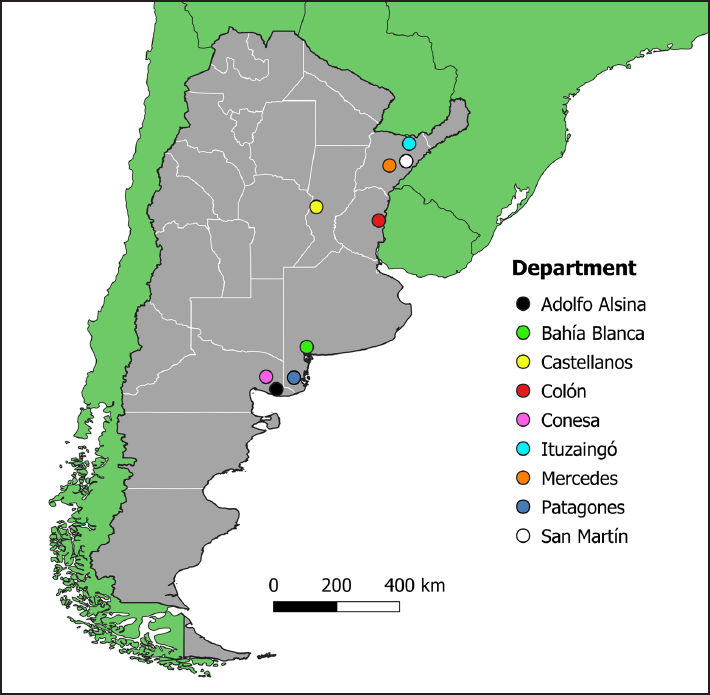In search of hepatitis E virus infection in wild boar and cattle from Argentina
DOI:
https://doi.org/10.31687/saremNMS22.1.2Keywords:
epidemiological surveillance, hepatitis E virus, Sus scrofaAbstract
Hepatitis E virus (HEV) is a pathogen with zoonotic potential that affects domestic pigs, wild boar Sus scrofa, and humans, among other species. The HEV has been reported in wild boar from Argentina and Uruguay, but knowledge about the epidemiology of this virus is still very scarce in this region. The objective of this study was to evaluate the circulation of HEV in wild boar and cattle from Argentina through serological (ELISA) and molecular (PCR) analyses. All samples were negative. However, we stress the importance of reporting negative cases since these represent key inputs in future research and risk analysis, mainly in association with the potential for virus transmission between wild boar and susceptible native species.
References
Anheyer-Behmenburg, H. E., K. Szabo, U. Schotte, A. Binder, G. Klein, & R. Johne. 2017. Hepatitis E virus in wild boars and spillover infection in red and roe deer, Germany, 2013–2015. Emerging Infectious Diseases 23:130–133.
Ballari, S. A., et al. 2019. Sus scrofa. Categorización 2019 de los mamíferos de Argentina según su riesgo de extinción. Lista Roja de los mamíferos de Argentina (SAyDS–SAREM, eds.). <http://cma.sarem.org.ar>.
Barrios-Garcia, M. N., & S. A. Ballari. 2012. Impact of wild boar (Sus scrofa) in its introduced and native range: a review. Biological Invasions 14:2283–2300.
De Souza, A. J., et al. 2012. HEV infection in swine from Eastern Brazilian Amazon: evidence of coinfection by different subtypes. Comparative Immunology, Microbiology & Infectious Diseases 35:477–485.
Forero, J., et al. 2015. Serological evidence of hepatitis E virus infection in Antioquia, Colombia slaughtered pigs. Revista MVZ Córdoba 20:4602–4613.
Halbur, P. G., et al. 2001. Comparative pathogenesis of infection of pigs with hepatitis E viruses recovered from a pig and a human. Journal of Clinical Microbiology 39:918–923.
Harrison, L. H., & E. DiCaprio. 2018. Hepatitis E virus: an emerging foodborne pathogen. Frontiers in Sustainable Food Systems 2:14.
Hoofnagle, J. H., K. E. Nelson, & R. H. Purcell. 2012. Hepatitis E. New England Journal of Medicine 367:1237–244.
Huang, F. F., et al. 2002. Detection by reverse transcription-PCR and genetic characterization of field isolates of swine hepatitis E virus from pigs in different geographic regions of the United States. Journal of Clinical Microbiology 40:1326–332.
Jakob-Hoff, R. M., S. C. MacDiarmid, C. Lees, P. S. Miller, D. Travis, & R. Kock. 2014. Manual of procedures for wildlife disease risk analysis. World Organisation for Animal Health, Paris. Published in association with the International Union for Conservation of Nature and the Species Survival Commission.
Kozyra, I., A. Jabłoński, E. Bigoraj, & A. Rzeżutka. 2020. Wild Boar as a sylvatic reservoir of hepatitis E virus in Poland: a cross-sectional population study. Viruses 12:1113.
Kwok, S., & R. Higuchi. 1989. Avoiding false positives with PCR. Nature 339:237–238.
La Sala, L. F., J. M. Burgos, A. L. Scorolli, K. VanderWaal, & S. M. Zalba. 2021. Trojan hosts: the menace of invasive vertebrates as vectors of pathogens in the Southern Cone of South America. Biological Invasions 23:2063–2076.
Mirazo, S., et al. 2018. Serological and virological survey of hepatitis E virus (HEV) in animal reservoirs from Uruguay reveals elevated prevalences and a very close phylogenetic relationship between swine and human strains. Veterinary Microbiology 213:21–27.
Munné, M. S., et al. 2006. Identification of the first strain of swine hepatitis E virus in South America and prevalence of anti-HEV antibodies in swine in Argentina. Journal of Medical Virology 78:1579–1583.
Pisano, M. B., M. G. Martinez-Wassaf, S. Mirazo, A. Fantilli, J. Arbiza, J. D. Debes, & V. E. Ré. 2018. Hepatitis E virus in South America: The current scenario. Liver International 38:1536–1546.
Pisano, M. B., M. Winter, N. Raimondo, M. G. Martínez-Wassaf, S. D. Abate, & V. E. Ré. 2019. New pieces in the transmission cycle of the hepatitis E virus in South America: first viral detection in wild boars from Argentina. Transactions of the Royal Society of Tropical Medicine and Hygiene 113:497–499.
Purcell, R. H., et al. 2011. Hepatitis E virus in rats, Los Angeles, California, USA. Emerging Infectious Diseases 17:2216–2222.
R Core Team. 2019. R: A language and environment for statistical computing. R Foundation for Statistical Computing, Vienna, Austria. <https://www.R-project.org/>.
Rein, D. B., G. A. Stevens, J. Theaker, J. S. Wittenborn, & S. T. Wiersma. 2012. The global burden of hepatitis E virus genotypes 1 and 2 in 2005. Hepatology 55:988–997.
Reinhardt, G., H. Ibarra, S. Riedemann, & I. Vega. 2003. Swine hepatitis E preliminary serological study in Chile. Archivos de Medicina Veterinaria 35:233–236.
Schielke, A., et al. 2015. Hepatitis E virus antibody prevalence in hunters from a district in Central Germany, 2013: A cross-sectional study providing evidence for the benefit of protective gloves during disembowelling of wild boars. BMC Infectious Diseases 15:1–8.
Spahr, C., T. Knauf-Witzens, T. Vahlenkamp, R. G. Ulrich, & R. Johne. 2018. Hepatitis E virus and related viruses in wild, domestic and zoo animals: A review. Zoonoses Public Health 65:11–29.
Stallknecht, D. E. 2007. Impediments to wildlife disease surveillance, research, and diagnostics. Current Topics in Microbiology and Immunology 315:445–461.
Van der Poel, W. H. 2014. Food and environmental routes of hepatitis E virus transmission. Current Opinion in Virology 4:91–96.
Vitral, C. L., M. A. Pinto, L. L. Lewis-Ximenez, Y. E. Khudyakov, D. R. dos Santos, & A. M. Gaspar. 2005. Serological evidence of hepatitis E virus infection in different animal species from the Southeast of Brazil. Memórias do Instituto Oswaldo Cruz 100:117–122.
Wei, D., Y. Zhao, Y. Jia, X. Hao, J. Situ, W. Yu, F. Huang, & H. Jiang. 2020. Hepatitis E virus infection in buffaloes in South China. Arquivo brasileiro de medicina veterinária e zootecnia 72:1122–1126.

Downloads
Published
How to Cite
Issue
Section
License
Copyright (c) 2022 Luciano F. La Sala, Soledad Barandiaran, María E. Eirin, Ximena Ferrara Muñiz, Sergio Abate, Silvia Sánchez Puch, Verónica Mathet, Cecilia M. Delfino

This work is licensed under a Creative Commons Attribution-NonCommercial 4.0 International License.

